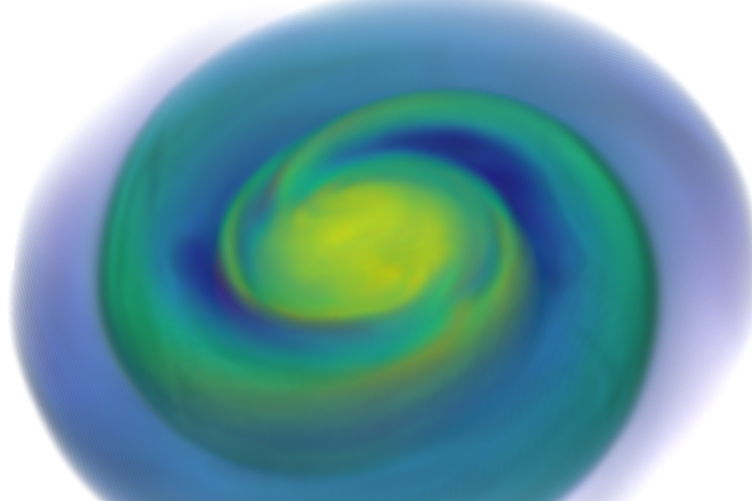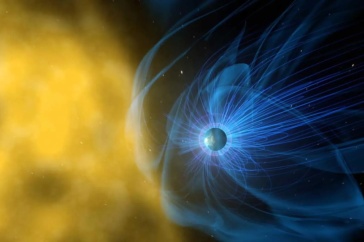
Illustration showing the immediate aftermath of two neutron stars colliding. The central region is a more massive neutron star forming from the cores of the original neutron stars. Colors show temperature differences. (Illustration by Francois Foucart)
Researchers at the University of New Hampshire were selected to join a newly formed Network for Neutrinos, Nuclear Astrophysics, and Symmetries Physics Frontier Center (PFC) funded by the National Science Foundation. The center, which will receive $10.6 million over five years, aims to reveal new information about the physics in extreme astrophysical environments.
Assistant professor of physics Francois Foucart, a recent Department of Energy (DOE) Early CAREER Research Award winner, will lead the research effort at UNH, one of 13 institutions included in the center based at UC Berkeley. It will allow scientists to address major questions in physics and astrophysics by focusing on the collision of neutron stars and the explosion of massive stars in supernovae.
The initiative brings new collaborative research to UNH and will fund at least one post-doctorate researcher in the next few years. Both undergraduate and graduate students will contribute to the research.
Foucart expects the effort to bolster physics at UNH, broaden the university’s research profile and have an impact on all those involved.
“This places UNH within a national network including many of the leading groups in nuclear astrophysics today,” says Foucart. “It should allow UNH students and post-doctorate researchers to interact with some top scientists in the field and gain visibility themselves.”
Foucart says the UNH hub will work on numerical simulations of colliding neutron stars, which are which are extremely dense objects with roughly the mass of the sun and an average diameter of approximately 10 miles.
“We are trying to determine what happens when two of these very compact objects collide,” says Foucart. “We want to understand the type of observable signal that they produce ̶ gravitational ̶ waves, burst of gamma-rays, emission due to nuclear reactions in matter ejected by the collision ̶ and to determine what these observable signals can tell us about nuclear physics, the production of heavy elements and more.”
The PFC builds upon an NSF-funded research hub in multi-messenger nuclear astrophysics that was established in 2017, and a foundation of support for this field of research by the Office of Nuclear Physics within the U.S. Department of Energy’s Office of Science. In multi-messenger astronomy, researchers combine observations of different particles and waves from a range of observatories to address longstanding questions in the field.
Foucart says understanding the properties of dense matter is an important open question in nuclear physics today. Studying neutron stars provides an alternative path to studying dense matter in a way that cannot be produced in laboratory. It is also thought that many of the heavy atomic nuclei observed today in the solar system were formed by these events.
“Understanding neutron star mergers and supernovae is key if we want to figure out where and when atomic nuclei found in the solar system, such as gold, platinum and more, are formed, and how they were spread through the universe,” says Foucart.
The PFC will also study neutrino physics in neutron star mergers and supernovae. Neutrinos are very low-mass particles that usually do not interact much with normal matter, making them difficult to study. At the very high densities present in neutron stars, they actually play a major role in the evolution of these systems. Neutron star mergers and supernovae thus provide researchers with a very useful environment to test neutrino physics and try to better understand a class of particles that remain poorly understood.
Researchers at the University of New Hampshire were selected to join a newly formed Network for Neutrinos, Nuclear Astrophysics, and Symmetries Physics Frontier Center (PFC) funded by the National Science Foundation. The center, which will receive $10.6 million over five years, aims to reveal new information about the physics in extreme astrophysical environments.
Assistant professor of physics Francois Foucart, a recent Department of Energy (DOE) Early CAREER Research Award winner, will lead the research effort at UNH, one of 13 institutions included in the center based at UC Berkeley. It will allow scientists to address major questions in physics and astrophysics by focusing on the collision of neutron stars and the explosion of massive stars in supernovae.
The initiative brings new collaborative research to UNH and will fund at least one post-doctorate researcher in the next few years. Both undergraduate and graduate students will contribute to the research.
Foucart expects the effort to bolster physics at UNH, broaden the university’s research profile and have an impact on all those involved.
“This places UNH within a national network including many of the leading groups in nuclear astrophysics today,” says Foucart. “It should allow UNH students and post-doctorate researchers to interact with some top scientists in the field and gain visibility themselves.”
Foucart says the UNH hub will work on numerical simulations of colliding neutron stars, which are which are extremely dense objects with roughly the mass of the sun and an average diameter of approximately 10 miles.
“We are trying to determine what happens when two of these very compact objects collide,” says Foucart. “We want to understand the type of observable signal that they produce ̶ gravitational ̶ waves, burst of gamma-rays, emission due to nuclear reactions in matter ejected by the collision ̶ and to determine what these observable signals can tell us about nuclear physics, the production of heavy elements and more.”
The PFC builds upon an NSF-funded research hub in multi-messenger nuclear astrophysics that was established in 2017, and a foundation of support for this field of research by the Office of Nuclear Physics within the U.S. Department of Energy’s Office of Science. In multi-messenger astronomy, researchers combine observations of different particles and waves from a range of observatories to address longstanding questions in the field.
Foucart says understanding the properties of dense matter is an important open question in nuclear physics today. Studying neutron stars provides an alternative path to studying dense matter in a way that cannot be produced in laboratory. It is also thought that many of the heavy atomic nuclei observed today in the solar system were formed by these events.
“Understanding neutron star mergers and supernovae is key if we want to figure out where and when atomic nuclei found in the solar system, such as gold, platinum and more, are formed, and how they were spread through the universe,” says Foucart.
The PFC will also study neutrino physics in neutron star mergers and supernovae. Neutrinos are very low-mass particles that usually do not interact much with normal matter, making them difficult to study. At the very high densities present in neutron stars, they actually play a major role in the evolution of these systems. Neutron star mergers and supernovae thus provide researchers with a very useful environment to test neutrino physics and try to better understand a class of particles that remain poorly understood.
-
Written By:
Brooks Payette | College of Engineering and Physical Sciences

















































